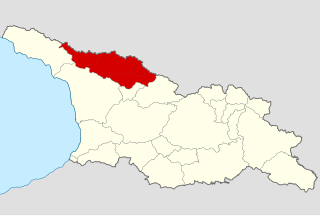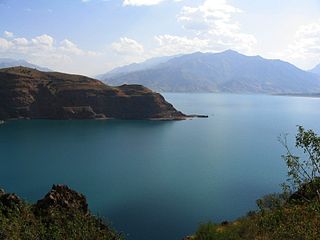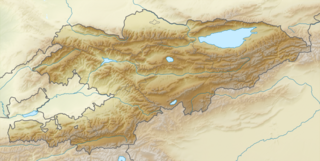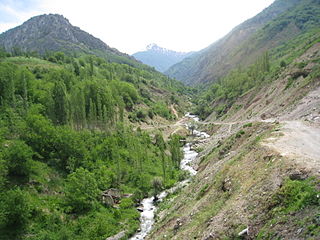
Lenin Peak, or Ibn Sina (Avicenna) Peak, rises to 7,134 metres (23,406 ft) in Gorno-Badakhshan (GBAO) on the border of Tajikistan and Kyrgyzstan, and is the second-highest point of both countries. It is considered one of the less technical 7000 m peaks in the world to climb and it has by far the most ascents of any 7000 m or higher peak on Earth, with every year seeing hundreds of mountaineers make their way to the summit. Lenin Peak is the highest mountain in the Trans-Alay Range of Central Asia, and in the Pamir Mountains in Tajikistan it is exceeded only by Ismoil Somoni Peak. It was thought to be the highest point in the Pamirs in Tajikistan until 1933, when Ismoil Somoni Peak was climbed and found to be more than 300 metres higher. Two mountains in the Pamirs in China, Kongur Tagh and Muztagh Ata, are higher than the Tajik summits.

Tashkent is the capital and largest city of Uzbekistan, as well as the most populated city in ex-Soviet Central Asia with a population in 2018 of 2,485,900. It is located in the north-east of the country close to the Kazakhstan border.

Svaneti or Svanetia is a historic province of Georgia, in the northwestern part of the country. It is inhabited by the Svans, an ethnic subgroup of Georgians.

The Kuhistani Badakhshan Autonomous Region (Tajik: Вилояти Мухтори Кӯҳистони Бадахшон, Viloyati Muxtori Köhistoni Badaxshon; also known as Gorno-Badakhshan is an autonomous region in eastern Tajikistan. Located in the Pamir Mountains, it makes up 45% of the land area of the country but only 3% of its population.

Zhetysu or Semirechye is a historical name of a part of Central Asia, corresponding to the southeastern part of modern Kazakhstan. It owes its name, meaning "seven rivers" in Kazakh and Persian, to the rivers which flow from the south-east into Lake Balkhash.
Adelung is a surname. Notable people with the surname include:

The Tashkent class consisted of a single destroyer leader, built in Italy for the Soviet Navy just before World War II. Three others were ordered from shipyards in the Soviet Union, but they were cancelled before they were laid down as they were too difficult to build with the existing technology in Soviet shipyards. Completed in 1940, Tashkent participated in the Sieges of Odessa and Sevastopol in 1941–1942, during which she ferried reinforcements and supplies into those cities, evacuated wounded and refugees, and provided naval gunfire support for Soviet troops. The ship was badly damaged twice by Axis bombers before she was sunk in harbor in mid-1942. Her wreck refloated in 1944, but it was too badly damaged to be worth repairing and was scrapped after the war.

Lake Charvak is a water reservoir in Bostanliq District in the northern part of Tashkent Region, Uzbekistan, separating Ugam (north), Pskem (east), and Chatkal (south) ranges. The reservoir was created by erecting a 168 m (551 ft) high stone dam on the Chirchiq River, a short distance downstream from the confluence of Pskem, Ko'ksu and Chatkal rivers in the western Tian Shan mountains, which provide the main volume of water. Currently the confluence cannot be seen and all three rivers discharge directly into Charvak. The reservoir capacity is 2 km3 (0.48 cu mi).

≠≥≥≥≤§§§·←×−

Mount Garmo is a mountain of the Pamirs in Tajikistan, Central Asia, with a height reported to be between 6,595 metres and 6,602 metres.

The Pskem River or Pishkom is a river of Tashkent Region in Uzbekistan in the Pskem Mountains.

The Pskem Mountain Range or Pishkom Mountains, a range in the west Tien Shan, is a natural border between Kyrgyzstan and Uzbekistan. It extends over 160 km from north-east to south-west in the extreme north-eastern finger of Uzbekistan's Tashkent Region. The range is a water divide between Pskem River to the north and the Sandalysh River, Chatkal River, and Ko'ksu River to the south. The highest elevations are attained in the north-east of the range: Mount Adelung and Mount Beshtor.

The ZSU-23-4 "Shilka" is a lightly armored Soviet self-propelled, radar guided anti-aircraft weapon system (SPAAG).

The Aksarsay is a river in the northeast area of Tashkent Region, Uzbekistan. It originates in the Pskem Range of the Tianshan Mountains and flows into the Pskem River, at the bridge over the Pskem near the water level of Lake Charvak.

Bostanliq is a raion (district) of Tashkent Region in Uzbekistan. The capital lies at Gazalkent.

The Darvaz Range or Darvoz Range is a mountain range in the Western Pamirs, in Gorno-Badakhshan Autonomous Province of Tajikistan. Its name derives from the historical region of Darvaz.

Ugam Range is a mountain range in South Kazakhstan Region of Kazakhstan and Tashkent Region in Uzbekistan. It is part of Western Tian Shan. The range runs from northeast to southwest; in the northeast, it joins the Talas Alatau; in the southwest, it gradually flattens towards the valley of the Syr Darya. The total length of Ugam Range is approximately 100 kilometres (62 mi), the highest peaks are over 4,000 metres (13,000 ft). It marks the border between Kazakhstan and Uzbekistan.

Tashkent was the lead ship of her class of destroyer leaders, built in Italy for the Soviet Navy just before World War II. The problems of the previous Leningrad-class destroyer leaders demonstrated that Russian design experience had atrophied in the years since the Russian Revolution of 1917, and the Soviets contracted for design assistance from Fascist Italy in the mid-1930s. Delivered without any armament in 1939, Tashkent was given a temporary armament when she entered service with the Black Sea Fleet in late 1940. She was having her permanent armament installed when the Germans invaded the Soviet Union in mid-1941.




















